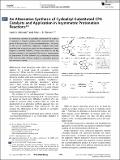Files in this item
An alternative synthesis of cycloalkyl-substituted CPA catalysts and application in asymmetric protonation reactions
Item metadata
| dc.contributor.author | McLean, Liam | |
| dc.contributor.author | Watson, Allan J. B. | |
| dc.date.accessioned | 2021-09-15T17:30:10Z | |
| dc.date.available | 2021-09-15T17:30:10Z | |
| dc.date.issued | 2021-09-15 | |
| dc.identifier | 275671304 | |
| dc.identifier | f3b51a22-d331-472a-a2e9-3042fa6c3687 | |
| dc.identifier | 85115713343 | |
| dc.identifier | 000700167600008 | |
| dc.identifier.citation | McLean , L & Watson , A J B 2021 , ' An alternative synthesis of cycloalkyl-substituted CPA catalysts and application in asymmetric protonation reactions ' , European Journal of Organic Chemistry , no. 35 , pp. 4943-4945 . https://doi.org/10.1002/ejoc.202100980 | en |
| dc.identifier.issn | 1434-193X | |
| dc.identifier.other | ORCID: /0000-0002-1582-4286/work/100172890 | |
| dc.identifier.uri | https://hdl.handle.net/10023/23964 | |
| dc.description | LAM thanks the EPSRC (grant number EP/S027165/1) for postdoctoral funding. | en |
| dc.description.abstract | An alternative synthesis of cycloalkyl-substituted CPA catalysts is reported. A Negishi coupling offers improved yields and purity of the necessary 1,3,5-tri(cycloalkyl)benzenes. Limitations in the use of commercial organozinc reagents have been identified and a robust procedure for the preparation of these reagents is detailed. Similarly, a robust procedure for the key Kumada coupling is also provided. The route is demonstrated by preparation of three different tri(cycloalkyl)aryl-substituted CPAs and the utility of these catalysts in asymmetric protonation reactions is shown. | |
| dc.format.extent | 4 | |
| dc.format.extent | 2979071 | |
| dc.language.iso | eng | |
| dc.relation.ispartof | European Journal of Organic Chemistry | en |
| dc.subject | Asymmetric protonation | en |
| dc.subject | Brønsted acid | en |
| dc.subject | Catalysis | en |
| dc.subject | Cross-coupling | en |
| dc.subject | Enantioselectivity | en |
| dc.subject | QD Chemistry | en |
| dc.subject | NDAS | en |
| dc.subject.lcc | QD | en |
| dc.title | An alternative synthesis of cycloalkyl-substituted CPA catalysts and application in asymmetric protonation reactions | en |
| dc.type | Journal article | en |
| dc.contributor.sponsor | EPSRC | en |
| dc.contributor.institution | University of St Andrews. School of Chemistry | en |
| dc.contributor.institution | University of St Andrews. Sir James Mackenzie Institute for Early Diagnosis | en |
| dc.identifier.doi | 10.1002/ejoc.202100980 | |
| dc.description.status | Peer reviewed | en |
| dc.identifier.grantnumber | EP/S027165/1 | en |
This item appears in the following Collection(s)
Items in the St Andrews Research Repository are protected by copyright, with all rights reserved, unless otherwise indicated.

